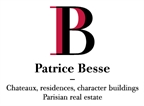A late 16th and 18th century, urban manor listed as a historical monument, with lounges for artistic and gastronomic projects, 15 km from Deauville -
A late 16th and 18th century, urban manor listed as a historical monument, with lounges for artistic and gastronomic projects, 15 km from Deauville.
Paris, 190 km away, can be easily reached via the A13 motorway. With several daily links, the train journey takes 2 hours. On the edge of the Auge Country, Pont-l'Evêque has been in a key position, where the Bayeux-Rouen road meets that going from Lisieux to the sea, since the 12th century. It is also a large administrative and judicial centre. This explains the large numbers of half-timbered manors as well as brick and stone mansions belonging to the leading citizens. Furthermore, important buildings were built in the 19th century such as the Restoration court, a prison with neo-classical architecture which has, amongst others, housed René-la-Canne as well as the distilleries.
Running along a street, the manor facade features a porchway providing access to a courtyard, bordered by a wing set at right angles. A large, walled garden is separated from the courtyard by an outbuilding. Further on, a second small outbuilding stands on the edge of a copse of tall trees.
The 16th century manor and its 18th century extensionIt spans three levels, one of which is under the rafters. Laid out in an L-shape, the long facade extending along the street features seven bays. It is constructed entirely from half-timbering, built on quarry stone block lower sections. The protruding second level is supported on corbels, some of which still top a sculpted scroll. The openings are rectangular, that of the porchway slightly arched. A wing at the back stands at right angles. A brick extension was added in the 18th century. It features three semi-circular carriage openings on the ground floor. The manor house can be accessed via two entrances. One, under the porchway, opens directly into one of the two reception rooms. The other, set in the corner of the two buildings, was redesigned in the 19th century.
The ground floor
The entrance door is typical of the Restoration era, with a fanlight and coloured rectangular stained-glass windows. The hall is paved with cement tiles. It gives access to a little study, the reception rooms and a corridor which leads to a living room. A stairway, with elm wood steps, goes upstairs. The decor of the two rooms overlooking the street is characteristic of the 18th century. Parquet flooring with inlaid squares or laid in a herringbone pattern, floor-to-ceiling panelling as well as arch moulding and cornices on the ceiling. A large decorative feature, including cherubs, horns of plenty and birds of paradise amongst other things, adorns the centre. Three openings have been made in the wall separating the two rooms to create transparency. A 19th century fireplace is made of a moulded, very rare, copper veined, black marble. The living room, with windows overlooking the courtyard, awaits restoration. It can be reached via a wooden door, typical of the Renaissance era, with carved pilasters in the uprights, the carved heads of the initial builders and scrolls supporting a console. It houses a Renaissance style, monumental dressed stone fireplace. The jambs, sculpted in half columns with Corinthian order capitals, support moulded corbels. The hearth is lined with small brick. The three reception lounges pay witness to a rich past and are ideal for cultural or gastronomic activities, as they were once previously used for such purposes by the owners of the property.
The first floor
The stairway goes up to a landing which gives access to both wings. On the road side, a lounge, a bedroom, an anteroom, a shower room, a toilet, a small dining room and a kitchen. The many period features include French ceilings, with original decors, alternating grain, herringbone pattern parquet flooring and tall, 18th century cupboard doors. The anteroom ...


